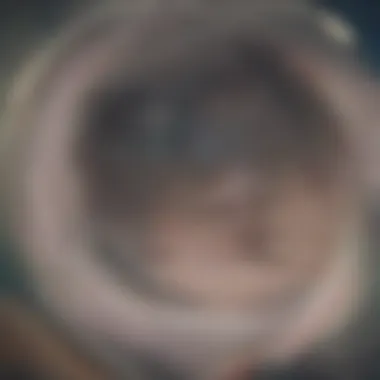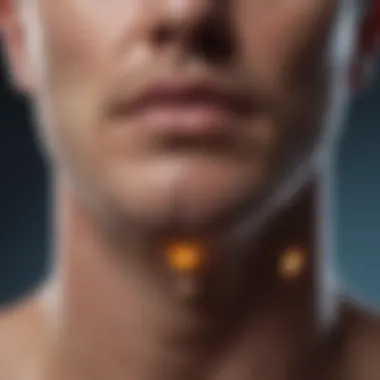Understanding Treatment Approaches for Thyroid Nodules


Intro
Thyroid nodules are prevalent in the general population, and their management presents a nuanced challenge for healthcare professionals. Understanding the intricacies of these nodules is critical, not just to determine the best course of treatment, but also to reassure patients about their health outcomes.
With varying approaches from observation to surgical intervention, this article delves into the complexities underlying these management strategies. It is important to evaluate risk factors, utilize appropriate diagnostic imaging, and conduct thorough histopathological assessments. Each step plays a vital role in deciding the right path forward for individuals affected by thyroid nodules.
Key Concepts
Definition of Primary Terms
In order to grasp the complexities involved in managing thyroid nodules, it is essential to define several key terms:
- Thyroid Nodule: A lump or mass in the thyroid gland that can vary in size and may be benign or malignant.
- Observation: This involves monitoring the nodule over time without immediate intervention.
- Surgical Intervention: A more aggressive approach, involving the physical removal of the nodule, typically indicated for suspected malignancies.
- Histopathological Assessment: The microscopic examination of tissue to determine the presence and type of disease.
Related Concepts and Theories
Further exploration into the pathophysiology of thyroid nodules reveals that they are generally classified into three main categories: benign, malignant, and indeterminate. Understanding these classifications aids in risk assessment and treatment planning.
Related theories surrounding thyroid function, such as the role of thyroid hormones and TSH (Thyroid Stimulating Hormone), also play a crucial part in determining how nodules affect overall body health. Research indicates that some nodules may produce excess hormones, leading to various health issues.
Future Directions
Gaps Identified in Current Research
Despite the wealth of knowledge on thyroid nodules, several gaps remain in understanding their long-term implications. Current studies often lack long-term patient outcomes and the impact of emerging therapies. Additional research is required to fully understand the effectiveness of these newer treatments.
Suggestions for Further Studies
It is essential that future studies focus on:
- Longitudinal Studies: To track the progression of thyroid nodules over time in a variety of demographics.
- Comparative Analysis: Between traditional surgical approaches and new, minimally invasive techniques.
- Patient Quality of Life Assessments: To evaluate the psychological impact of living with thyroid nodules, aiding in comprehensive thyroid health strategies.
Prelims to Thyroid Nodules
Thyroid nodules are a prevalent condition that many individuals encounter during their lives. Understanding thyroid nodules is an essential aspect of thyroid health and disease management. This section lays the foundation for further exploration of their diagnosis and treatment options. Knowing about these nodules can lead to better patient outcomes, as various treatment approaches exist depending on the characteristics of the nodule.
Definition of Thyroid Nodules
Thyroid nodules are solid or fluid-filled lumps that form within the thyroid gland, which is located in the neck. These nodules can vary significantly in size, texture, and composition. They may be benign or malignant. In many cases, nodules are detected incidentally during imaging tests for unrelated issues, often showing no symptoms. However, their presence can raise concerns, warranting careful evaluation and management. The identification of whether a nodule is benign or potentially cancerous has become a central focus in the clinical setting.
Prevalence and Epidemiology
The prevalence of thyroid nodules increases with age. Studies indicate that about 50% of people aged over 60 may have at least one thyroid nodule visible on ultrasound. The presence of nodules is more common among women than men, with estimates suggesting that women are five to ten times more likely to develop thyroid nodules compared to their male counterparts.
Factors influencing the epidemiology of thyroid nodules include:
- Geographic location: Certain regions exhibit a higher prevalence tied to dietary iodine levels.
- Underlying health conditions: Individuals with autoimmune disorders or a history of radiation exposure show higher rates of nodules.
Research highlights that about 90% of thyroid nodules are benign, yet the vigilance in assessing their nature is essential due to the remaining 10% that may be malignant.
Etiology of Thyroid Nodules
Understanding the etiology of thyroid nodules is essential for effective management and treatment. Thyroid nodules can arise from various factors, both intrinsic and extrinsic. Identifying the causes not only aids healthcare professionals in determining the appropriate treatment strategy but also empowers patients with knowledge about their condition. Therefore, this section delves into how these nodules can be classified into benign and malignant types and what factors might contribute to their development.
Benign Versus Malignant Nodules
Thyroid nodules are typically categorized into two types: benign and malignant. Benign nodules are more common and may include conditions like colloid nodules or adenomas. These nodules usually do not present significant risks and often require simple monitoring or medical management. On the other hand, malignant nodules can indicate thyroid cancer. Although the majority of nodules are benign, accurate differentiation between the two is crucial to prevent unnecessary treatment or anxiety.
Diagnosis often involves ultrasound evaluations and biopsies to assess the cellular structure of the nodule. Fine-needle aspiration biopsy is a critical tool, allowing healthcare providers to obtain tissue samples and classify the nodules appropriately. An early and precise diagnosis can significantly impact the treatment path.
Risk Factors for Development
Various factors contribute to the development of thyroid nodules. Some of these are:
- Age and Gender: Thyroid nodules are more common in women and in people aged over 60, prompting further investigation.
- Family History: A familial tendency towards thyroid disorders can increase the risk of developing nodules.
- Exposure to Radiation: Previous exposure to radiation, especially during childhood, is a well-documented risk factor for the development of thyroid nodules and even thyroid cancer.
- Iodine Deficiency: Insufficient iodine intake may lead to goiters and, subsequently, the formation of nodules.
It's important to recognize and understand these risk factors for early detection and appropriate management. Regular check-ups become vital for individuals at higher risk.
Diagnostic Evaluation of Thyroid Nodules
The diagnostic evaluation of thyroid nodules is critical for determining their nature and planning appropriate management strategies. Accurate assessment enables healthcare professionals to differentiate between benign and malignant nodules, which is essential for patient safety and effective treatment. By utilizing a combination of clinical evaluations, imaging techniques, and biopsies, clinicians can gather pertinent information that guides decision-making. An effective diagnostic process minimizes unnecessary procedures and ensures that patients receive the most suitable care tailored to their specific conditions.


Clinical Assessment
The clinical assessment of thyroid nodules begins with a thorough patient history and physical examination. Healthcare providers inquire about symptoms such as difficulty swallowing, changes in voice, or signs of hyperthyroidism. Physical examination typically includes palpating the thyroid gland to identify nodules' size, consistency, and mobility. These characteristics can provide initial clues regarding the nodules' nature. Furthermore, risk factors such as age, gender, and family history of thyroid disease are considered during the assessment. A clinical evaluation sets the foundation for further diagnostic procedures.
Imaging Techniques
Diagnostic imaging methods play a pivotal role in assessing thyroid nodules. These techniques help visualize the nodules' structure and characteristics, significantly influencing management decisions. Here are some widely used imaging modalities:
Ultrasound
Ultrasound is often the first-line imaging technique utilized for thyroid nodules. It is non-invasive and does not involve radiation exposure. The key characteristic of ultrasound lies in its ability to provide detailed information about the nodule's size, shape, and echogenicity.
One unique feature of ultrasound is its capability to identify cystic versus solid nodules, which is vital in evaluating potential malignancy risks. The advantages include its accessibility, low cost, and ability to guide further interventions like biopsies. However, ultrasound does have limitations; it may miss small nodules or fail to fully characterize some lesions without additional imaging.
CT Scans
Computed Tomography (CT) scans offer a detailed cross-sectional view of the thyroid and surrounding structures. The primary aspect of CT scans is their capacity to provide high-resolution images that can help assess larger masses or detect additional pathologies. Moreover, it is beneficial for patients with a history of radiation exposure, as it allows for precise localization of nodules.
However, the disadvantage of CT scans is that they expose patients to ionizing radiation, which can be a concern, particularly for younger individuals. Additionally, CT may not always provide enough information to differentiate between benign and malignant nodules definitively.
MRI
Magnetic Resonance Imaging (MRI) is another option for assessing thyroid nodules, primarily when there are concerns about nearby structures or complications. The key characteristic of MRI is that it employs a magnetic field and radio waves to produce detailed images without exposing patients to radiation. MRI is especially beneficial in complex cases or in patients with anatomical abnormalities.
Nevertheless, MRI can be time-consuming and costly compared to other modalities. Additionally, it is not commonly the first-choice imaging method for evaluating nodules due to its practical limitations in routine thyroid assessments.
Fine-Needle Aspiration Biopsy
Fine-needle aspiration biopsy (FNAB) is a critical component of the diagnostic evaluation of thyroid nodules. It involves using a thin needle to extract cellular samples from a nodule to assess its cytology. FNAB helps quantify the risk of malignancy and typically includes ultrasound guidance for optimal accuracy.
The main benefit of FNAB is its minimally invasive nature, allowing for rapid results. This procedure can distinguish between benign and malignant nodules in most cases, affecting the subsequent management strategies directly. It does carry some risks, such as bleeding or infection, but these occurrences are rare. In summary, FNAB serves as a reliable and informative technique in the clinical evaluation of thyroid nodules.
Management Strategies for Thyroid Nodules
Managing thyroid nodules involves a careful assessment of the individual patient's situation. It is essential to recognize the diverse nature of these nodules. They can exhibit benign or malignant characteristics. Choosing the right management strategy can impact patient outcomes significantly. Factors like nodule size, symptoms, and patient health history inform these strategies. The primary management approaches are observation, medication therapy, and surgical interventions.
Observation and Monitoring
Observation can be a very valid option for many patients. This strategy focuses on regularly monitoring the nodule without immediate treatment. In many cases, nodules are discovered incidentally during imaging for other reasons. Some do not grow or cause symptoms. Regular ultrasound evaluations can help track changes in size or appearance. If there is no significant change over time, this approach can minimize unnecessary procedures.
Benefits include:
- Reduced risk of surgery complications.
- Lower healthcare costs for patients.
- Less psychological stress associated with surgery.
Medication Therapy
Medication therapy includes using hormones to manage nodules. Specific treatments like Levothyroxine and other hormonal therapies might be effective, depending on the nodule's characteristics.
Levothyroxine
Levothyroxine is a synthetic thyroid hormone. It is often prescribed. The drug aims to suppress the secretion of thyroid-stimulating hormone (TSH). This can lead to a decrease in nodule size, which is a beneficial effect.
A key characteristic of Levothyroxine is its wide availability and well-established safety profile. Most patients tolerate it well, making it a popular initial choice for management. However, this method may not be suitable for all patients, especially those with nodules that show potential malignancy.
Advantages:
- Non-invasive treatment option.
- Easy administration and monitoring.
Disadvantages:
- Risk of over-treatment, leading to hyperthyroidism symptoms.
Other Hormonal Treatments
Other hormonal treatments may include a variety of thyroid hormone preparations. These alternatives can serve specific needs when Levothyroxine is not suitable or insufficient.
The key characteristic of these treatments is their tailored nature. Physicians can adjust dosages according to individual patient needs. This flexibility is beneficial in managing thyroid disorders, including nodules.
Advantages:
- Customizable to patient’s hormonal profile.
- Different formulations may suit various preferences.
Disadvantages:


- Limited data on long-term effectiveness compared to Levothyroxine.
Surgical Interventions
In cases where nodules are large, symptomatic, or determined to be malignant, surgical intervention may be the best course of action. Surgical options include thyroid lobectomy and total thyroidectomy.
Thyroid Lobectomy
Thyroid lobectomy involves removing one lobe of the thyroid gland. This partial removal can be beneficial in reducing symptoms and, in some cases, can entirely remove a relevant nodule.
A key characteristic is its minimally invasive nature compared to total removal. Many patients experience a shorter recovery time and lower risk of complications.
Advantages:
- Preserves function of the remaining thyroid tissue.
- Less extensive than total thyroidectomy.
Disadvantages:
- Risk of leaving behind malignant tissue if not thoroughly evaluated.
Total Thyroidectomy
Total thyroidectomy is the complete removal of the thyroid gland. This approach is typically reserved for confirmed malignancy or very large nodules causing significant symptoms.
Its key characteristic is the definitive nature of removing all thyroid tissue, thus eliminating the risk of recurrent nodular issues.
Advantages:
- Provides a clear path to managing malignant nodules.
- Reduces the risk of future nodular development.
Disadvantages:
- Requires lifelong hormone replacement therapy.
- Increased risk of complications, such as vocal cord injury or hypoparathyroidism.
Histopathological Considerations
The histopathological evaluation of thyroid nodules plays a critical role in determining the appropriate management strategies. This process involves examining tissue samples under a microscope to identify the nature of the nodules, whether they are benign or malignant. Understanding the histopathological characteristics provides invaluable information that influences clinical decisions regarding patient care.
Understanding Thyroid Pathology
Thyroid pathology involves the study of diseases that affect the thyroid gland, including nodules and glandular disorders. It encompasses the analysis of cellular structures and their function. Through histopathology, we can observe changes in cellular architecture that may indicate disease progression.
Key elements of thyroid pathology include:
- Cellular Composition: This refers to the types of cells present in the nodule, which can indicate benign conditions like colloid nodules or potentially malignant changes in follicular or papillary thyroid carcinoma.
- Architectural Patterns: Recognizing patterns such as follicular growth or cellular atypia helps in differentiating between benign and malignant nodules.
- Invasive Features: Detection of invasion into surrounding tissues is crucial in confirming malignancy.
Understanding these aspects assists clinicians in tailoring treatment approaches for patients.
Classification of Nodules
The classification of thyroid nodules is fundamental for diagnosis and treatment planning. Histopathological evaluation can categorize nodules based on several criteria:
- Benign Nodules: These typically include colloid nodules, hyperplastic nodules, and adenomas, which are not associated with significant risk of cancer.
- Malignant Nodules: These encompass various types of thyroid cancer, such as papillary, follicular, medullary, and anaplastic thyroid cancer. Early recognition of these classifications is essential for timely intervention.
- Indeterminate Nodules: Some nodules cannot be clearly classified as benign or malignant based on initial biopsy findings, necessitating further investigation or monitoring.
Accurate classification impacts the management of thyroid conditions significantly. It informs decisions regarding the need for surgery, ongoing observation, or additional diagnostic testing.
An integrated approach combining histopathological assessment with clinical evaluation ensures effective treatment planning. Regular updates in classification techniques and investigational methods improve the understanding of patient outcomes.
Patient Education and Informed Decision-Making
Patient education is a cornerstone of effective medical treatment, particularly when it comes to thyroid nodules. The complexity of the diagnosis and treatment options necessitates that patients have a good understanding of their condition. It helps patients to make informed choices regarding their health. This process can lead to better health outcomes and greater patient satisfaction.
One significant element is the discussion of treatment options. Patients should be aware of both the potential benefits and risks associated with each form of treatment. For instance, observation may be recommended for benign nodules, while surgical intervention might be necessary for malignant ones. Clarifying these choices ensures that patients feel empowered in their healthcare journey.
Moreover, informed decision-making includes understanding why certain tests are performed and what the results might indicate. This involves education on diagnostic imaging techniques, such as ultrasound or MRI, and their roles in guiding treatment. Patients benefit when they grasp the rationale behind the recommended procedures.
Informed patients are also more likely to adhere to follow-up plans. They understand the need for regular monitoring and can recognize potential complications or changes in their health. Being proactive in managing their condition fosters trust in the healthcare team and reinforces a sense of control.
“Education is the most powerful weapon which you can use to change the world.”
– Nelson Mandela
Discussing Treatment Options
When discussing treatment options for thyroid nodules, clarity and comprehensiveness are vital. Healthcare providers should present a range of choices, outlining both conservative approaches like active surveillance and more aggressive tactics like surgery. Patients need to understand why certain treatments are proposed. This includes discussing:


- Active surveillance: Monitoring nodules over time without immediate intervention. This is often preferred for nodules that appear benign.
- Medication therapy: Options like Levothyroxine, which may be prescribed to manage hormone levels or address other thyroid issues.
- Surgical options: Details about thyroid lobectomy versus total thyroidectomy, including recovery expectations and long-term implications.
Each option should be explained in layman's terms to ensure that the patient comprehends the information fully. Encouraging questions can help clarify any uncertainties and build a collaborative relationship.
Addressing Patient Concerns
Addressing patient concerns is an integral aspect of the treatment process. Patients often have anxieties related to their diagnosis, treatment efficacy, and potential side effects. Acknowledging these concerns demonstrates empathy and builds rapport.
Common concerns may include:
- Fear of cancer or malignancy.
- Anxiety about surgical procedures.
- Worries regarding the impact of treatment on daily life.
Providers should take the time to listen actively and validate these feelings. Providing evidence-based answers can alleviate fears. For instance, discussing statistical outcomes related to various treatment strategies can reassure patients about their choices.
It is also beneficial to discuss potential support systems, both professional and personal, that patients can lean on during their treatment journey. Resources such as support groups or counseling services can provide additional comfort. This holistic approach helps patients feel supported and included in their care process, reinforcing the importance of teamwork in managing thyroid health.
Follow-Up Care for Thyroid Nodules
Effective follow-up care is crucial in managing thyroid nodules due to their potential impact on a patient’s health. Regular monitoring allows healthcare providers to observe changes in the nodules, assess any new symptoms, and determine when further intervention may be necessary. This aspect of care is fundamental in ensuring appropriate management and timely responses to any changes in the patient's condition.
Importance of Regular Monitoring
Regular monitoring plays a significant role in the management of thyroid nodules. This process involves routine assessments that help track any variations in the nodule's characteristics over time. The benefits of consistent monitoring include:
- Early Detection of Changes: Monitoring helps detect any increase in nodule size or changes in characteristics, which could indicate malignancy.
- Informed Decision Making: By keeping informed through regular assessments, both patients and healthcare providers can make better decisions regarding treatment options.
- Customized Care Plan: Regular monitoring allows for the adjustment of management plans based on the current status of the nodules, ensuring each patient receives the most appropriate care.
It is essential for patients to adhere to their follow-up schedule, as this can significantly influence the overall outcome of their treatment.
Timing of Follow-Up Assessments
The timing of follow-up assessments can vary based on several factors, including the initial findings of the thyroid nodule and the specific characteristics assessed. Generally, the following guidelines are observed:
- Initial Follow-Up: After the initial diagnosis and assessment, a follow-up appointment is often recommended within six months. This timeframe allows healthcare providers to evaluate any immediate changes.
- Subsequent Monitoring: If the nodule is stable and determined to be benign, follow-ups can typically be scheduled annually. However, if there are concerns about its nature, more frequent evaluations may be necessary.
- Adapting to Patient Needs: The timing of follow-ups should be personalized according to the patient's health status, risk factors, and any symptoms presented.
Ensuring a structured follow-up plan can enhance the management of thyroid nodules and improve patient outcomes by promoting proactive care.
Emerging Therapies and Research
The field of thyroid nodule management is rapidly evolving, making the topic of emerging therapies and research pivotal for both patients and healthcare professionals. These advancements can significantly influence treatment options and outcomes for thyroid nodules. Understanding these innovations helps in identifying new potential strategies that might be less invasive or more effective than traditional approaches, allowing for improved patient care.
Innovations in Treatment Approaches
Recent years have seen several innovations in treatment methodologies for thyroid nodules. One of the most significant developments is the increased use of robot-assisted minimally invasive surgery. This method offers enhanced precision, reduced recovery times, and minimized surgical impact compared to conventional techniques.
Moreover, there is ongoing research on molecular testing techniques that analyze the genetic profile of thyroid nodules. This technology can help distinguish between benign and malignant nodules more effectively, thus guiding clinicians toward appropriate management strategies.
- Radiolabeled therapies are another emerging area. Treatments using isotopes like iodine-131 can target specific nodules, a significant step forward for patients who are not candidates for surgery.
- Thermal ablation techniques have gained traction as well. Techniques such as laser and microwave ablation provide options for treating benign nodules that produce symptoms without necessitating surgical intervention.
Overall, these innovations pave the way for personalized medicine in easy and manageable forms. They stress the necessity for continuous educational updates for healthcare providers in the domain of thyroid care.
Current Research Trends
Research trends are shifting towards understanding the molecular biology of thyroid nodules. By studying the genetic alterations associated with these nodules, researchers aim to create more precise risk stratification models. These models will inform which patients require aggressive treatment versus those who can be monitored.
- Biomarkers identification is a key focus area. Identifying specific markers that correlate with nodule malignancy may revolutionize how practitioners approach diagnostics and management.
- Can artificial intelligence enhance imaging analyses? Yes, studies are underway to assess how AI technologies could improve the accuracy of ultrasound imaging in detecting and categorizing thyroid nodules.
Research into these areas not only aims to enhance treatment paradigms but also seeks to minimize unnecessary interventions for benign conditions.
In addition, patient-centric research is being prioritized. Understanding patient experiences and decision-making processes is essential for tailoring treatment to individual preferences and needs. This shift speaks to a broader movement towards shared decision-making in thyroid care.
As these emerging therapies and research trends continue to develop, they highlight the necessity for clinician vigilance and adaptability. Each advancement holds the potential to significantly refine treatment protocols and improve patient outcomes.
Culmination
The conclusion of this article serves as a pivotal summation of the knowledge surrounding thyroid nodules and their treatment. It underlines the significance of understanding the multifaceted approaches available, highlighting that managing thyroid nodules extends beyond mere diagnosis and treatment. This should involve a thorough comprehension of patient-specific needs, a view into emerging research, and effective follow-up strategies.
Summary of Key Points
In reviewing the extensive topic of thyroid nodules, certain key points emerge:
- Prevalence: Thyroid nodules are common. Both benign and malignant forms require careful study.
- Diagnostic Methods: Fine-needle aspiration biopsy, imaging techniques including ultrasound, CT scans, and MRI are crucial in the diagnostic process.
- Management Strategies: Various methods are available, from observation to medications like Levothyroxine, and surgical interventions:
- Patient Education: Eliciting open communication and addressing concerns with patients promotes informed decision-making.
- Follow-Up Care: Regular monitoring and timely follow-ups are essential to mitigate risks associated with nodules.
- Emerging Therapies: Innovations in treatment approaches are on the horizon, offering new hope for patients.
- Thyroid Lobectomy
- Total Thyroidectomy
Future Directions in Research and Management
Looking ahead, several future directions in research and management warrant attention:
- Innovative Therapies: Research into less invasive treatment methods is ongoing, aiming to reduce recovery time and enhance patient comfort.
- Precision Medicine: Customizing treatment plans based on individual genetics and nodular characteristics is becoming increasingly relevant. This patient-centric approach holds promise.
- Longitudinal Studies: Initiating long-term studies to track outcomes in patients treated for thyroid nodules can shed light on the most effective intervention strategies.
- Technology in Monitoring: Digital health and telemedicine could revolutionize follow-up protocols, making assessment more accessible for patients.



